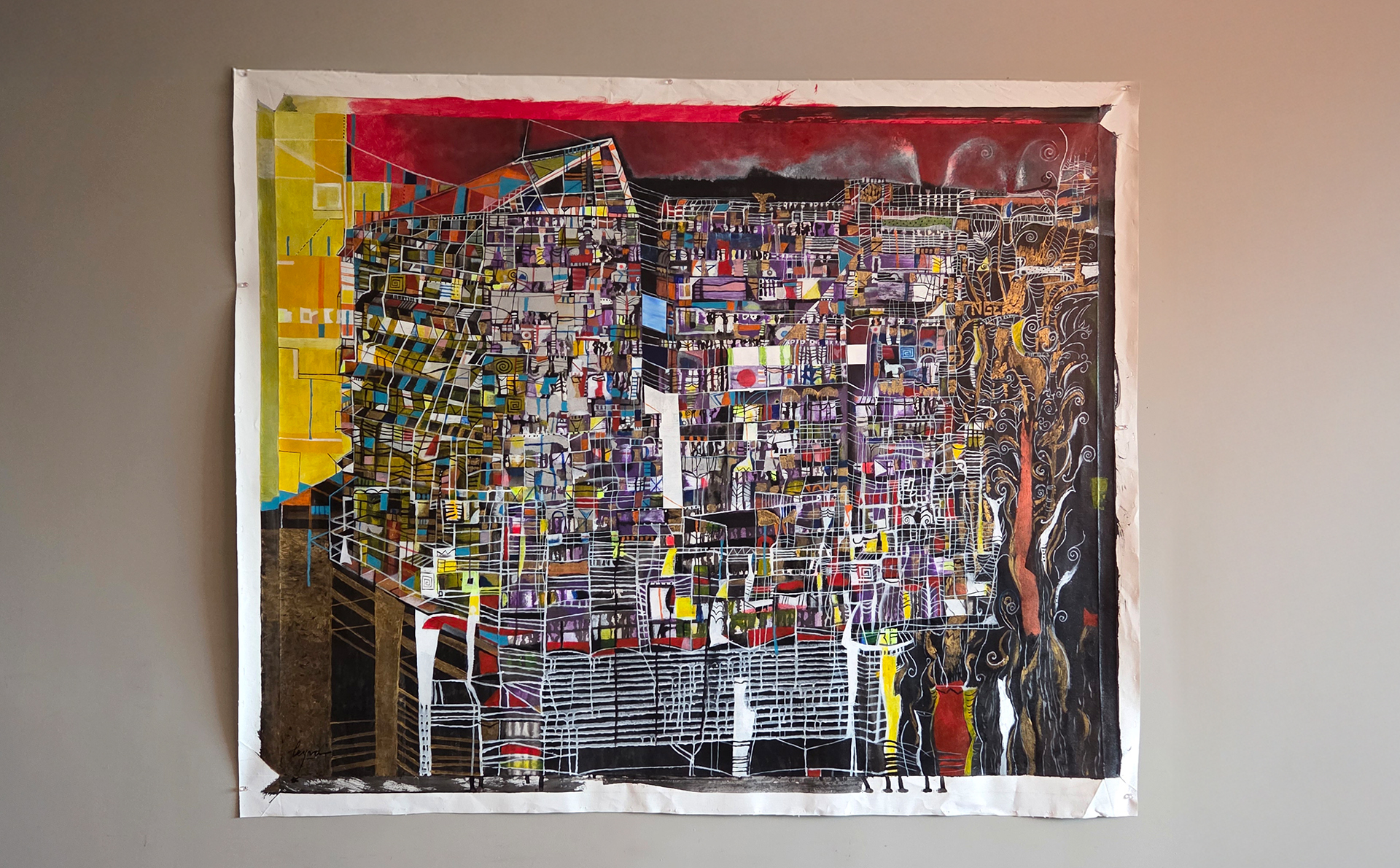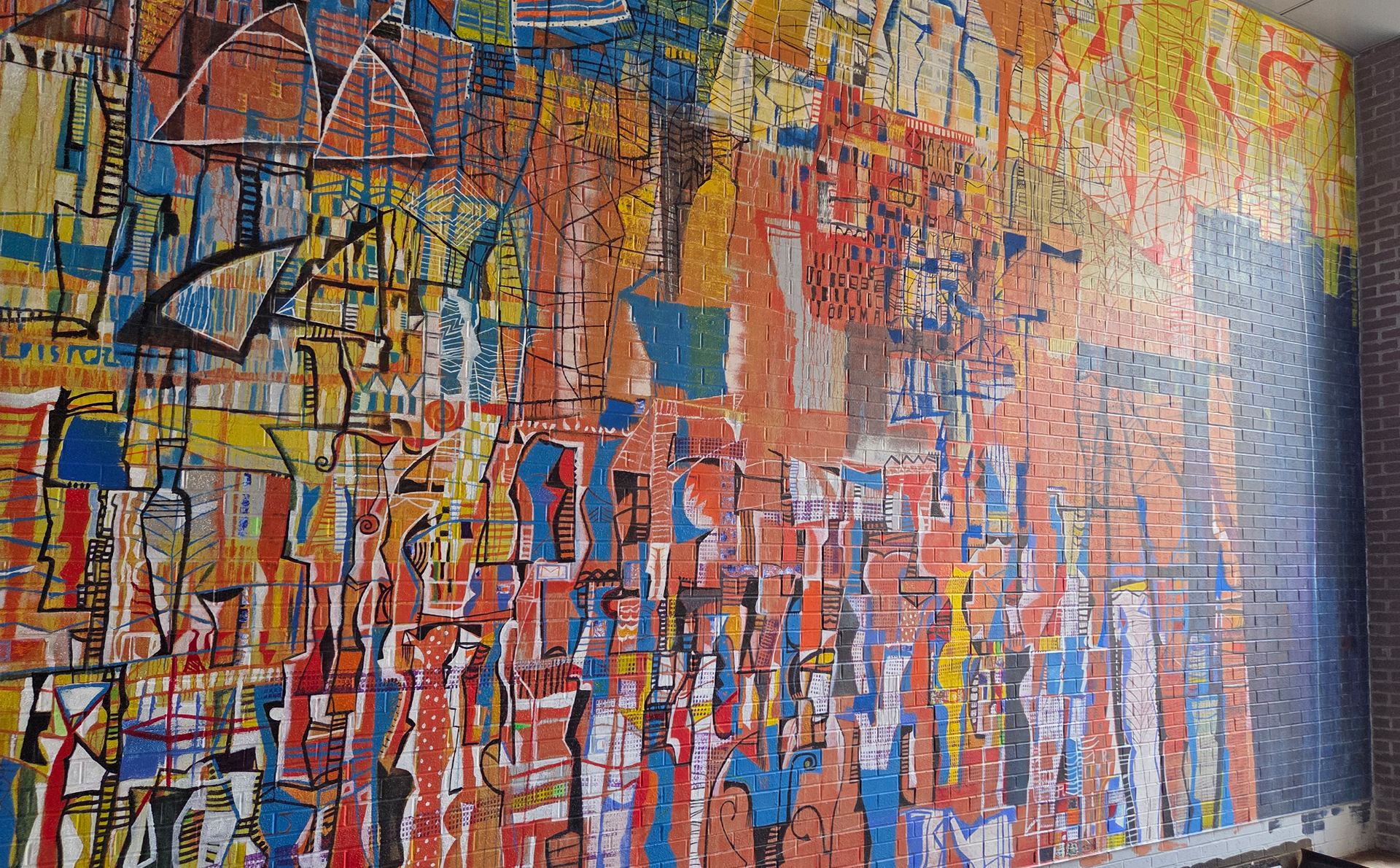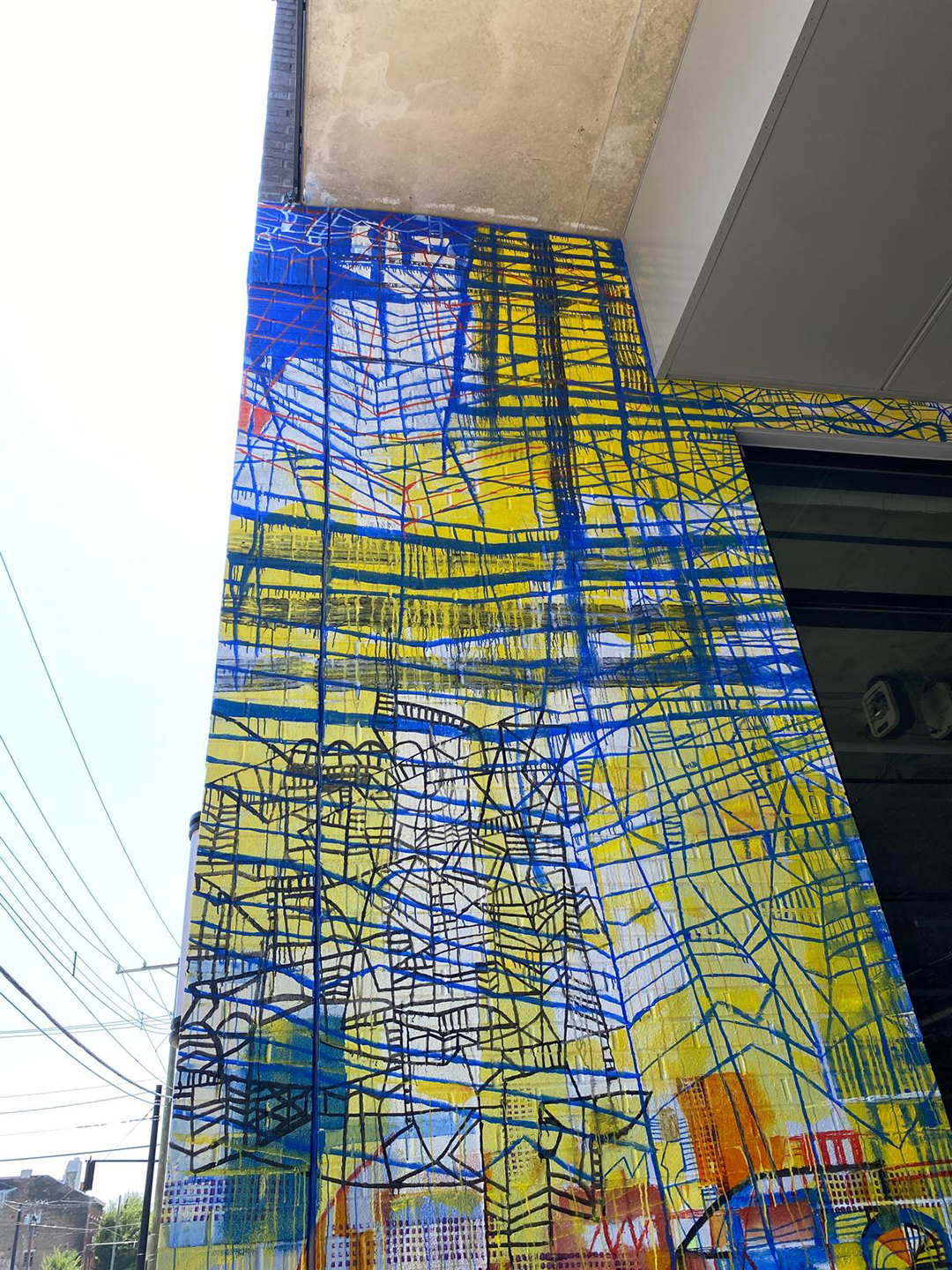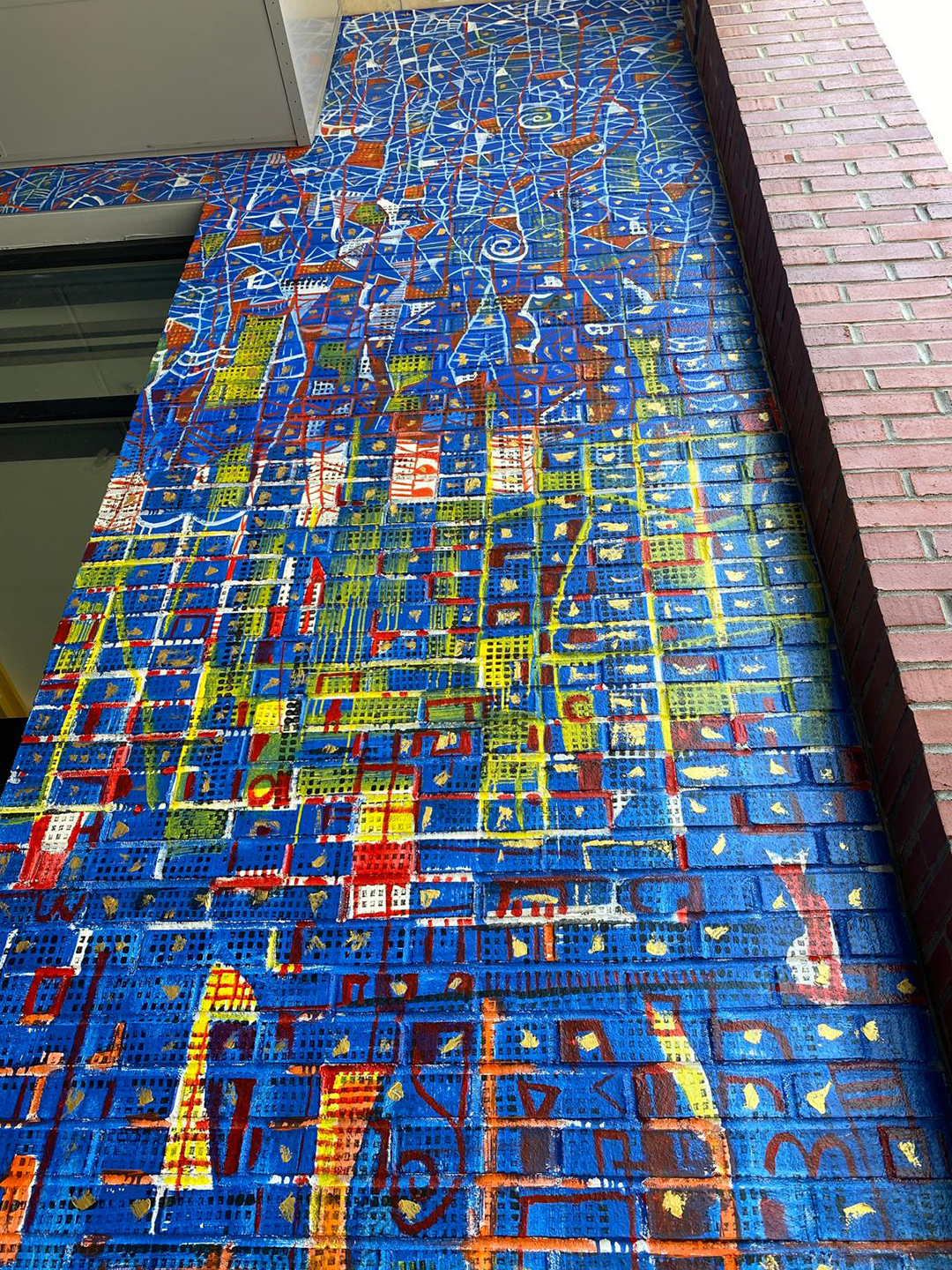
Image taken at the opening of the small parallel exhibition at Banz Studios.
Throughout my life, I have felt a peculiar pleasure whenever I’ve had the chance to witness a birth. These beginnings—first steps, embryonic shapes of future realities—emerge every minute, every second. They are part of the unending dynamic of existence in the physical realm. Most will go unnoticed, for only God can foresee the majestic tree that may rise from a given blade of grass.
Once again, I was fortunate enough to witness the birth of an artwork destined to capture the attention of Cincinnati’s residents. The Freeport Row Art Alley—at the intersection of Liberty and Elm Streets—now boasts a monumental new work by Esteban A. Leyva. This commission came through Banz Studios, with direct management by its Art Consultant and Project Manager, Chelsea Tucker Moore, who oversaw the entire process: from selecting the artist to coordinating the technical installation.
Chelsea discovered Esteban’s work while searching for proposals for this and other large-scale public art projects. The connection, she tells me, was immediate: his radiant palette and energy-charged compositions brought to mind the vitality of the favelas, yet anchored in a visual structure that masterfully combines complexity with simplicity. “His work speaks of family, love, and community,” she affirms. With over fourteen years of experience in art consulting and project management, Chelsea handled the local logistics and all necessary arrangements to bring the artist’s work to the city. From coordinating materials and transport to supervising the installation, her role was decisive in ensuring that the intervention not only met technical demands but also engaged organically with the space and its community. Beyond pictorial quality, she underscores Esteban’s personal integrity: describing him as a kind, warm, and patient man, with a vital and creative commitment reflected both in his artistic trajectory and in his personal life. “Seeing him with his wife after fifty years of marriage is simply beautiful,” she says. For her, the human dimension is inseparable from the impact of his work.

The artist standing before one of the mural’s sections.
I must also highlight the role of Cuban promoter Marcos Mena Cruz, founder of Óleos & Canvas, a project dedicated to representing and promoting Cuban art. With a track record that includes collaborations with companies such as Amazon, curatorial projects for Nuit Blanche, and the placement of works in prestigious private collections, Mena has turned his passion for cultural roots into an active mission: to create more opportunities for Cuban artists. It was he who facilitated access to Esteban’s physical works, mediated negotiations with the American side, and personally accompanied the artist in Cincinnati for the opening of a parallel exhibition of his work. He also served as translator and cultural liaison, ensuring that each stage—from the initial introduction to the completion of the mural—unfolded with clarity and mutual understanding.

Works on view in one of the rooms at Banz Studios.
The mural—now open to the city’s art lovers—is part of the Freeport Row multifamily development, led by Buckingham Companies, and covers 1,044 square feet on the brick walls of the alley. Executed in exterior-grade acrylic paint and durable sealants, the work was conceived specifically for the site and realized in strict adherence to the technical and aesthetic standards set forth in the approved proposal.
In this project, Banz Studios—founded by curator Allison Banzhaf—brought its renowned expertise in art consulting and production. Located in the heart of Cincinnati, just steps from Paul Brown Stadium, the studio has become a dynamic, versatile cultural hub. Its 4,500-square-foot space houses a gallery, library, naturally lit atrium, and rooftop terrace with panoramic city views, plus a kitchen designed for events. The program integrates the exhibition and sale of painting, sculpture, photography, and metal and resin works with comprehensive curatorial, framing, and installation services for clients in sectors ranging from healthcare and corporate to hospitality and residential. Among its recent milestones is the installation of over 1,100 works at Cincinnati Children’s Hospital, a large-scale project that reflects its capacity to execute complex productions while maintaining high aesthetic and technical standards.

Esteban on the scaffolding, mid-process.
To witness part of the making of this mural—which reaffirms Banz Studios’ role as a bridge between international creators and the city—was, without doubt, a multisensory experience. I had the chance to speak with Esteban and Mónica on many occasions: to revisit the few experiences we had shared and to discover all that binds us beyond a shared passion for art. His work brings to mind—despite differences in time, distance, and technique—the densely layered urban scenes René Portocarrero painted with an unusual autumnal energy in the early decades of the latter half of the twentieth century: visions of cities that buzz like cicadas. Cities that Esteban also unfurls like an urban palimpsest, resonant with echoes that span decades and geographies. In his lines, one can sense the cartographic pulse of Paul Klee, as if the invisible streets of a dreamed city emerged under the scorching suns of Beatriz Milhazes. In his planes of color, the constructive discipline of Mondrian and Torres-García dissolves into a tropical and contemporary vertigo. Impossible architectures like those Matta compressed between layers of pigment seem to murmur in unison, while Dubuffet lends graphic irreverence and Mehretu, the emotional topography of cities in flux. In this chromatic symphony beat, too, the rhythmic optics of Cruz-Diez and Soto, and the totemic force of Vigas—melding heritage and modernity in a single pictorial gesture. This legacy pulses almost painfully within the pictorial and, above all, energetic commotion, leaving us with a map that may not guide, but surely moves; a territory where abstraction does not impose forms, but opens portals to the city—and the inhabitants—who still dream of awakening within themselves.
Leyva will also have a future exhibition—not solo, but familial—at the Annex Gallery space, sometime in 2026. Beyond acknowledging his gesture of bridging two cultures and adding a new voice to Cincinnati’s urban landscape, we will talk about what we have learned from the pathological relationship between art and life. For if art does not serve to build bridges, I do not know what else it is for. As I bid farewell this mid-August weekend to such a cherished creator, the closing exchange between Rick Blaine and Captain Louis Renault in that monumental film Casablanca came to mind:
—Esteban, I think this is the beginning of a beautiful friendship.


















Comments powered by Talkyard.